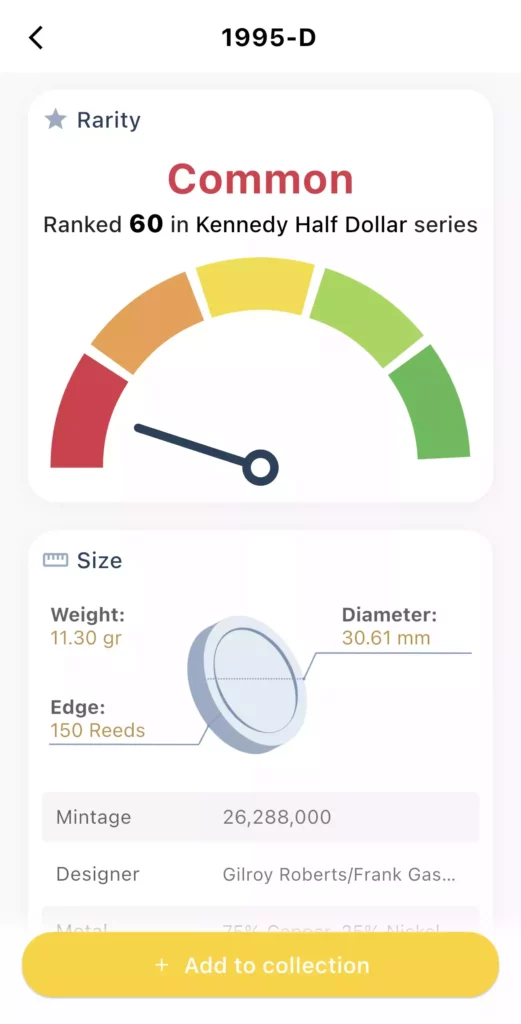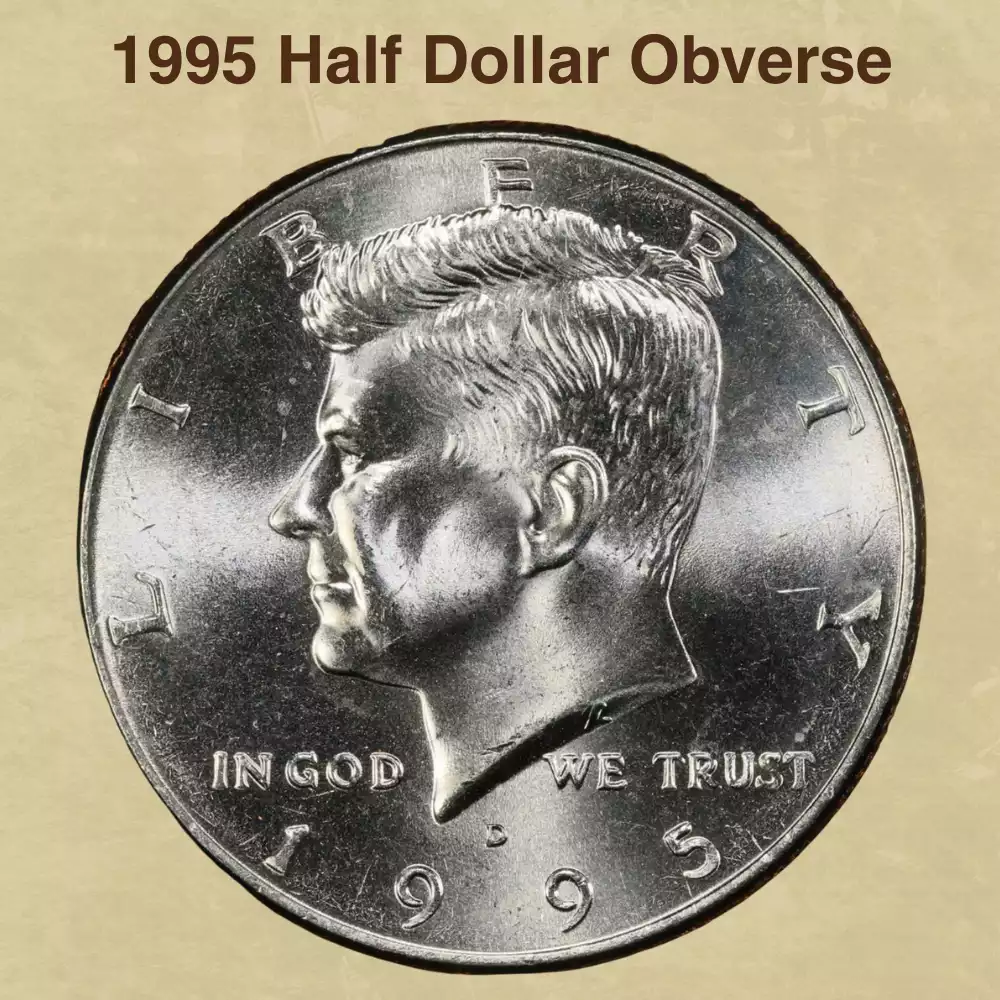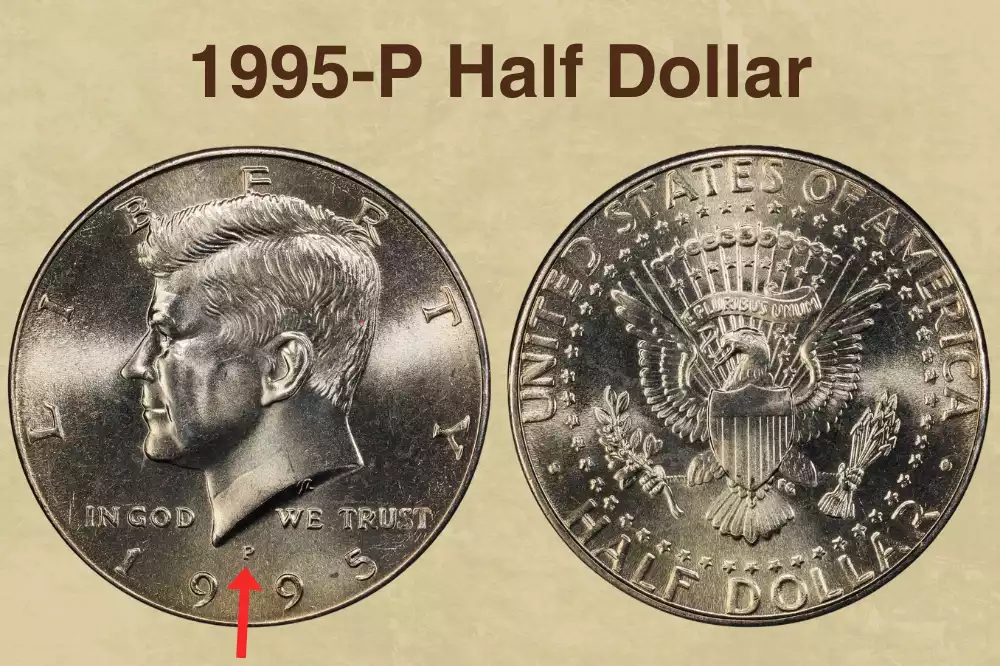Though half dollars bearing Kennedy’s portrait had largely exited circulation, the 1995 series illustrates how collector demand set it apart.
With over 52 million coins struck across three mints, the 1995 half dollar initially seemed destined for obscurity. Yet recent auction results show MS-67 specimens reaching $1,680—proving that grade, not age, drives modern half dollar values.
Though no single Kennedy half dollar issue is considered rare, business-strike pieces grading better than MS-66 are widely regarded as conditional rarities. The gap between face value and collector premiums reveals opportunities that many overlook.
1995 Half Dollar Value By Variety
Understanding 1995 half dollar values starts with recognizing the different types and their condition ranges. Most circulated examples fall into predictable value brackets, but the real distinctions emerge when examining mint state specimens and proof varieties.
1995 Half Dollar Value Chart
| TYPE | GOOD | FINE | AU | MS | PR |
|---|---|---|---|---|---|
| 1995 P Half Dollar Value | $2 | $1 | $1 | $13 | — |
| 1995 D Half Dollar Value | $2 | $1 | $1 | $17 | — |
| 1995 S DCAM Half Dollar Value | — | — | — | — | $10 |
| 1995 S Silver DCAM Half Dollar Value | — | — | — | — | $20 |
Tip: Use our CoinValueChecker App for real-time variety identification and current market values.
1995 Half Dollar Market Trend
Market Interest Trend Chart – 1995 Half Dollar
The 1995 half dollar’s market interest tells an unusual story of dramatic swings and steady recovery. Early activity remained modest until explosive growth in 2017, when trend indicators shot from 650 to peak levels of 4,540 in June.
What makes this pattern particularly noteworthy is the three complete collapse that followed—interest plummeted to virtually nothing before surging again to identical 4,540 peaks in April 2019.
This boom-bust-boom cycle reveals something interesting about collector behavior with this date. Rather than gradual appreciation, the 1995 Kennedy experiences periodic “rediscovery” events where collectors suddenly focus intense attention on the issue. The dramatic valleys between peaks suggest these aren’t sustained collecting trends but episodic recognition waves.
Since 2020, the pattern has shifted toward more consistent elevated interest around 3,500-4,500 trend points, suggesting the coin may have found its natural collector base.
For perspective on how the 1995 half dollar performs against other modern coins, check the US Coin Market Trend Ranking (Top 100) to see where this date stands among America’s most actively traded numismatic items.
History of The 1995 Half Dollar
The Kennedy half dollar, first issued in 1964 to honor President John F. Kennedy, entered its modern era after 1970 with a copper–nickel clad composition.
Within this context, 1995 stands out as a historically significant year for the series, marking an important turning point for collectors. That year, demand for the U.S. Mint’s annual proof and silver proof sets declined, which in turn reduced mintages across all coins in the sets.
Most notably, the 1995-S Proof silver half dollar was struck in only 679,985 pieces, the lowest proof mintage of the series until 2009. This sudden scarcity immediately elevated collector interest, firmly establishing it as a key date.
The 1995-S Silver Proof version, struck exclusively for collectors, carried a 90% silver composition that echoed the earliest Kennedy half dollars and reinforced appreciation for silver coinage. While regular circulation strikes from Philadelphia and Denver followed typical production numbers, the reduced proof output transformed 1995 into a landmark year.
The combination of declining demand and unusually low mintage reshaped the landscape for Kennedy half dollar collecting, making the 1995 issues some of the most historically significant of the modern era.
Also Read: 10 Most Historic Years of Kennedy Half Dollar (1964-2025)
Is Your 1995 Half Dollar Rare?
1995-P Half Dollar
1995-D Half Dollar
1995-S DCAM Half Dollar
1995-S Silver DCAM Half Dollar
Looking at the rarity assessment for 1995 half dollars reveals why most examples don’t command significant premiums.
The Philadelphia and Denver mint issues both fall into the “Uncommon” category, ranking 48th and 60th respectively within the Kennedy Half Dollar series— positions that reflect their abundant original mintages.
The 1995-S proof coins show different things. Both the standard DCAM and Silver DCAM proofs are classified as “Common,” ranking much lower at 459th and 78th positions. This occurs because proof coins were specifically made for collectors, ensuring better preservation rates compared to business strikes that entered circulation.
The numerical scores—ranging from 10 to 18 points—indicate relatively modest collector interest across all 1995 varieties. For a comprehensive analysis of where your specific coin stands, use our CoinValueChecker App to determine exact rarity assessments based on mint mark, condition, and variety.

To see how these 1995 issues compare against the scarcest Kennedy half dollars ever minted, explore the complete Kennedy Half Dollar Rarity Ranking (Top 100).
Key Features of The 1995 Half Dollar
In this section, we’ll examine the distinctive characteristics of the 1995 half dollar. Understanding these design elements helps collectors identify authentic specimens and assess their condition accurately.
The Obverse Of The 1995 Half Dollar

President Kennedy’s left-facing portrait dominates the obverse, created by Chief Engraver Gilroy Roberts using his earlier presidential medal design. This profile view captures Kennedy in a dignified pose that has remained unchanged since the coin’s 1964 debut.
The inscription “LIBERTY” curves along the upper rim, while “IN GOD WE TRUST” appears below Kennedy’s neckline. The date “1995” is positioned at the bottom, with mint marks located beneath Kennedy’s bust when present.
The Reverse Of The 1995 Half Dollar

Frank Gasparro’s reverse design features a heraldic eagle with outstretched wings, grasping 13 arrows in its right talon and an olive branch with 13 olives in its left. The eagle’s chest is protected by a shield, symbolizing American strength and readiness.
Thirteen stars radiate outward from above the eagle’s head, representing the original colonies. The inscriptions “UNITED STATES OF AMERICA” and “HALF DOLLAR” circle the design, with Gasparro’s initials “FG” appearing near the eagle’s right leg.
Other Features Of The 1995 Half Dollar
The 1995 half dollar measures 30.61mm in diameter with a thickness of 2.15mm and weighs exactly 11.34 grams. Its composition consists of outer layers containing 75% copper and 25% nickel, bonded to a pure copper core. The edge features distinctive reeding—vertical lines that prevent counterfeiting and provide grip during handling.
1995 Half Dollar Mintage & Survival Data
1995 Half Dollar Mintage & Survival Chart
Survival Distribution
| Type | Mintage | Survival | Survival Rate |
|---|---|---|---|
| P | 26,496,000 | 13,248,000 | 50% |
| D | 26,288,000 | 13,144,000 | 50% |
| S DCAM | 2,117,496 | 1,971,388 | 93.1% |
| S Silver DCAM | 679,985 | 645,985 | 94.9999% |
Based on the chart data, the 1995 half dollar series demonstrates a striking contrast in mintage figures across different mint locations and types.
The Philadelphia (P) and Denver (D) mints each struck approximately 26-27 million pieces, representing the vast majority of the total mintage with nearly identical quantities. These business strikes formed the backbone of the series and were intended for general circulation.
In stark contrast, the San Francisco Mint produced significantly fewer coins, with the standard proof (S DCAM) showing a modest mintage compared to the business strikes.
What’s more, the 1995-S Silver DCAM represents the smallest segment of the series with only 679,985 pieces minted, making it exceptionally scarce relative to its counterparts. However, it maintains a highest survival rate about 95% due to its collector-focused nature and careful preservation by numismatists.
For comprehensive survival analysis across the entire Kennedy half dollar series, the Kennedy Half Dollar Survival Ranking (Top 100) provides detailed comparative data on scarcity and availability patterns.
1995 Half Dollar Grading
Grading plays a crucial role in determining 1995 half dollar values, as condition dramatically affects market worth.
Most examples are commonly found in grades up to MS64, but become increasingly difficult to locate in higher mint state conditions. The population decreases significantly at MS66, with most examples typically found in mint sets and unopened rolls.
At MS67 and above, these coins transform into scarce specimens with fewer than 100 known examples in some cases. Professional grading becomes essential for valuable varieties and high-grade specimens, where subtle condition differences create substantial value disparities.
Kennedy half dollar grading follows the standard Sheldon Scale from 1 to 70, with key wear points including Kennedy’s cheek, jawbone, hair below the part, and the eagle’s central tail feathers on the reverse.
For immediate grade assessment and value determination, use our CoinValueChecker App to instantly evaluate your coin’s condition and market worth.

Understanding proper grading techniques helps collectors identify the difference between common circulated examples and valuable mint state specimens. If you want to master the complete evaluation process for all Kennedy half dollars, explore our comprehensive guide on How to Grade Kennedy Half Dollars.
1995 Half Dollar Value Guides
The 1995 half dollar was produced in four distinct varieties across three different mints, each with unique characteristics that collectors should understand.
The Philadelphia and Denver issues represent the standard clad composition. San Francisco took a different approach, producing only proof coins in both standard copper-nickel clad and 90% silver compositions, with dramatically lower production numbers that immediately set them apart in the collecting community.
1995 Half Dollar Varieties:
- 1995-P Half Dollar (Philadelphia mint)
- 1995-D Half Dollar (Denver mint)
- 1995-S DCAM Half Dollar (San Francisco mint)
- 1995-S Silver DCAM (San Francisco silver proof with Deep Cameo finish)
Understanding these distinctions helps collectors identify which variety they possess and assess its relative scarcity within the series. Each variety carries different mintage figures and collector demand levels.
1995-P Half Dollar Value

The 1995-P half dollar exhibits unique market characteristics stemming from its approximately 50% survival rate in mint state condition.
During the 1980s and early 1990s, Kennedy halves were neither collected nor circulated—they sat in Federal Reserve vaults and bank bags, developing contact marks and losing their gem status. This created an unexpected preservation challenge where the 1995-P Kennedy Half Dollar is very common in circulated grades up to about MS65 condition. In MS66 condition it becomes much more difficult to find, with higher grades becoming increasingly scarce.
This scarcity pattern creates unexpected market dynamics, evidenced by a remarkable auction result of $4,320 for an MS65 specimen in 2022 – demonstrating that even “common” modern Kennedy halves can achieve good premiums when preserved in exceptional condition.
1995-P Half Dollar Price/Grade Chart
Price by 1-70 Grade (Latest Auction Records Included)













